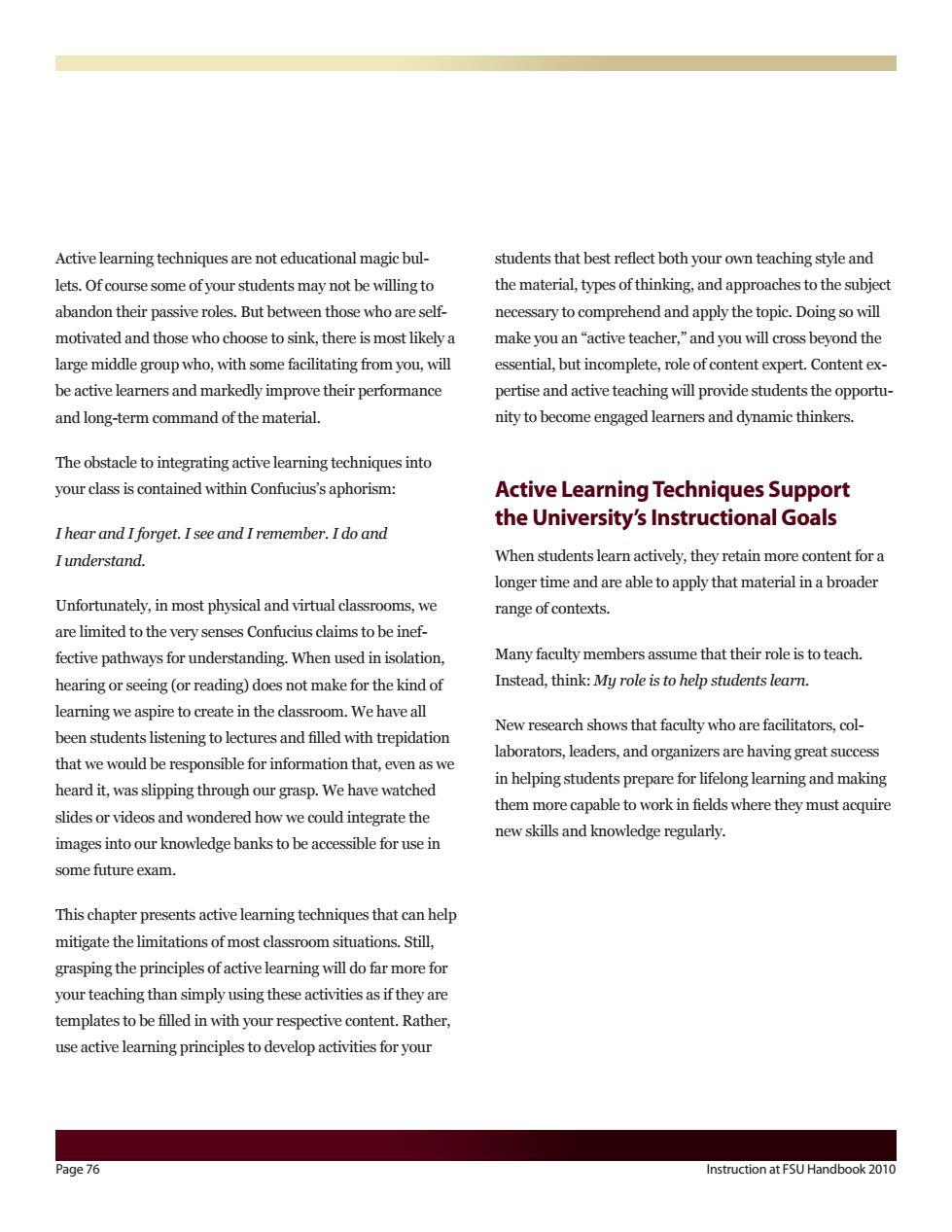正在加载图片...

Active learning techniques are not educational magic bul- students that best reflect both your own teaching style and lets.Ofcourse some of your students maynot be willingto the material,types of thinking.and approaches to the subject abandon their passive roles.But between those who are self necessary to comprehend and apply the topic.Doing so will motivated and those who choose to sink,there is most likely a make you an"active teacher,"and you will cross beyond the large middle group who,with some facilitating from you,will essential,but incomplete,role of content expert.Content ex- be active learers and markedly improve their performance pertise and active teaching will provide students the opportu and long-term command of the material. nity to become engaged learners and dynamic thinkers. The obstacle to integrating active learning techniques into your class is contained within Confucius's aphorism: Active Learning Techniques Support I hear and Iforget.Isee and I remember.Ido and the University's Instructional Goals Iunderstand. When students learn actively,they retain more content for a longer time and are able to apply that material in a broader Unfortunately,in most physical and virtual classrooms,we range of contexts. are limited to the very senses Confucius claims to be inef- fective pathways for understanding.When used in isolation, Many faculty members assume that their role is to teach hearing or seeing (or reading)does not make for the kind of Instead.think:My role is to help students learn. learning we aspire to create in the classroom.We have all been students listening to lectures and filled with trepidation New research shows that faculty who are facilitators,col- that we would be responsible for information that,even as we laborators,leaders,and organizers are having great success heard it,was slipping through our grasp.We have watched in helping students prepare for lifelong learning and making them more capable to work in fields where they must acquire slides or videos and wondered how we could integrate the images into our knowledge banks to be accessible for use in new skills and knowledge regularly some future exam. This chapter presents active learing techniques that can help mitigate the limitations of most classroom situations.Still, grasping the principles of active learning will do far more for your teaching than simply using these activities as if they are templates to be filled in with your respective content.Rather use active learning principles to develop activities for your age 76 Instruction at FSU Handbook 2010Page 76 Instruction at FSU Handbook 2010 students that best reflect both your own teaching style and the material, types of thinking, and approaches to the subject necessary to comprehend and apply the topic. Doing so will make you an “active teacher,” and you will cross beyond the essential, but incomplete, role of content expert. Content expertise and active teaching will provide students the opportunity to become engaged learners and dynamic thinkers. Active Learning Techniques Support the University’s Instructional Goals When students learn actively, they retain more content for a longer time and are able to apply that material in a broader range of contexts. Many faculty members assume that their role is to teach. Instead, think: My role is to help students learn. New research shows that faculty who are facilitators, collaborators, leaders, and organizers are having great success in helping students prepare for lifelong learning and making them more capable to work in fields where they must acquire new skills and knowledge regularly. Active learning techniques are not educational magic bullets. Of course some of your students may not be willing to abandon their passive roles. But between those who are selfmotivated and those who choose to sink, there is most likely a large middle group who, with some facilitating from you, will be active learners and markedly improve their performance and long-term command of the material. The obstacle to integrating active learning techniques into your class is contained within Confucius’s aphorism: I hear and I forget. I see and I remember. I do and I understand. Unfortunately, in most physical and virtual classrooms, we are limited to the very senses Confucius claims to be ineffective pathways for understanding. When used in isolation, hearing or seeing (or reading) does not make for the kind of learning we aspire to create in the classroom. We have all been students listening to lectures and filled with trepidation that we would be responsible for information that, even as we heard it, was slipping through our grasp. We have watched slides or videos and wondered how we could integrate the images into our knowledge banks to be accessible for use in some future exam. This chapter presents active learning techniques that can help mitigate the limitations of most classroom situations. Still, grasping the principles of active learning will do far more for your teaching than simply using these activities as if they are templates to be filled in with your respective content. Rather, use active learning principles to develop activities for your